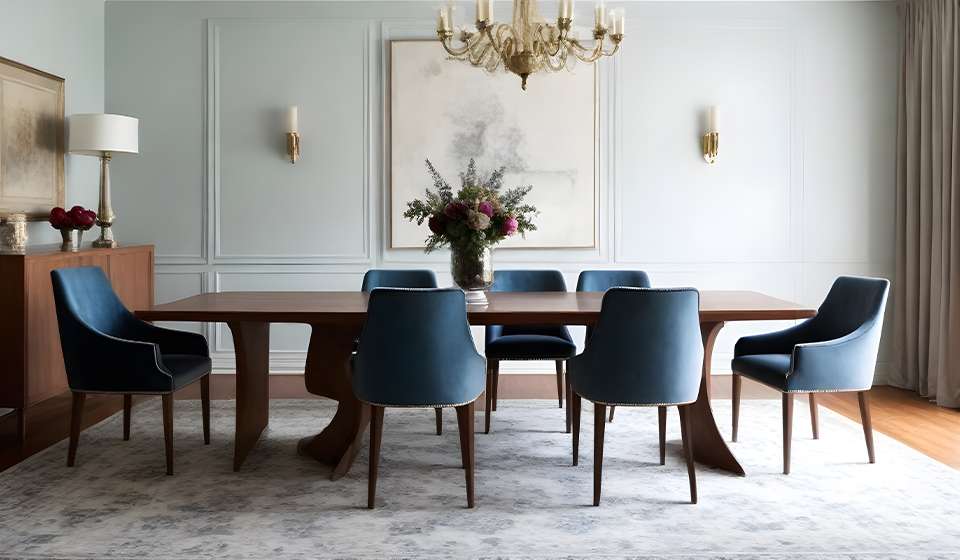As designers, we often find ourselves captivated by the rich tapestry of history that weaves its way through the evolution of spaces and furnishings. The dining room, in particular, holds a special place in the hearts and minds of many, serving as a hub for nourishment, connection, and sharing stories. In this guest blog post, we’ll delve into the fascinating history and the significance of dining rooms that will inspire designers from all backgrounds.
The Origins of the Dining Room
The concept of the dedicated dining room can be traced back to the ancient civilisations of Greece and Rome, where wealthy households would often have a separate room for the consumption of meals. These early dining rooms were not merely functional spaces but also showcases of opulence and social status, adorned with intricate dining tables, dining chairs, and dining ware.
As the Roman Empire expanded, the dining room evolved, with the introduction of the triclinium, a U-shaped arrangement of couches upon which guests would recline and enjoy their meals. This practice, known as the “Roman banquet,” became a symbol of power, prestige, and the refinement of culinary arts.
The Dining Room in the Middle Ages and Renaissance
During the Middle Ages, the dining room took on a more practical role, becoming a central gathering place for the household. In the great halls of castles and manor houses, families and servants would share meals at long communal tables, reinforcing the sense of community and hierarchy within the household.
As the Renaissance period dawned, the dining room once again became a canvas for artistic expression. The wealthy commissioned grand dining halls adorned with opulent tapestries, ornate chandeliers, and intricate woodcarvings, reflect the growing importance of hospitality and social display.
The Dining Room in the Modern Era
The 19th and 20th centuries saw a significant transformation in the role and design of the dining room. As the Industrial Revolution took hold, the middle class began to embrace the concept of the private, dedicated dining room, which became a symbol of social status and refined living.
Architectural styles such as Victorian, Edwardian, and Art Deco influenced the design of dining rooms, with features ranging from ornate fireplaces and built-in cabinetry to sleek, modern lines and bold colour schemes. The dining room also became a canvas for the growing field of interior design as it left its indelible mark on the spaces.
The Significance of the Dining Room Today
In the contemporary era, the dining room continues to hold a special place in the hearts and minds of designers and homeowners alike. While the formality of the past has given way to more casual and flexible dining experiences, the dining room remains a vital part of the modern home, serving as a gathering place for families, a setting for cherished meals, and a space for meaningful conversations.
Beyond its functional role, the dining room has also become a canvas for personal expression, with designers and homeowners embracing various styles, from the cosy and rustic to the sleek and minimalist. The dining room has also evolved to accommodate the changing needs of modern life by integrating technology, incorporating sustainable materials, and blending indoor and outdoor living spaces.
Common Dining Room Design Mistakes You Should Avoid
Ignoring the Importance of Adequate Lighting
One of the most common mistakes in dining room design is overlooking the importance of proper lighting. Adequate and well-placed lighting can significantly enhance the ambience and functionality of the space. Designers should consider a combination of overhead, task, and accent lighting to create a balanced and inviting atmosphere.
Oversized or Undersized Furniture
Another pitfall to avoid is selecting furniture that is either too large or too small for the dining room. Oversized pieces like dining chairs and tables can overwhelm the space, while undersized furniture can make the room feel disconnected and uncomfortable. Careful consideration of the room’s dimensions, the number of diners, and the desired seating arrangement is crucial to achieving the right scale and proportion.
Ignoring the Flow of Traffic
The layout and circulation within the dining room should also be a top priority for designers. Failing to consider traffic flow can lead to congestion, impeding the ease of movement and creating a sense of awkwardness. Designers should consider the placement of the table, chairs, and any other furniture or decor to ensure a smooth and seamless experience for those using the space.
Conclusion
The history of the dining room reflects the enduring significance of communal dining and shared experiences. Originating in mediaeval Europe, the dining room has evolved into a central feature of modern living, where memories are forged, and traditions are upheld. As we move forward, let us continue to embrace the timeless allure of the dining room and the rituals it represents.


